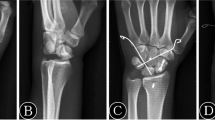Abstract
Objective
The exact prevalence of scapholunate dissociation (SLD) associated with distal radius fracture (DRF) and the effect of persistent SLD on the function of the wrist are not known. So, we examined the association between SLD and DRF and the effects of treatment on clinical outcomes.
Methods
Eight hundred and twenty-nine patients with 839 DRF were included in the study. The radiographs of the patients were examined with special reference to SLD both in pre- and post-reduction period. Persistent SLD cases were evaluated by the scoring system of Green and O’Brien at least 2 years after the fracture.
Results
Of the 839 fractures, 215 had SLD after the injury. When post-reduction radiographs were examined, SLD persisted in 98, but in 14 SLD was detected in the post-reduction period while not apparent in initial radiographs. So, a total of 112 patients (13.4 %) had persistent SLD. Nineteen patients were lost to follow-up and remaining 93 wrists examined clinically. Seventy-nine had pain on the scapholunate joint and 14 had not. When these patients were evaluated by Green and O’Brien system, symptomatic patients had fair or poor results but asymptomatic had good. The association between DRF and SLD is 13.4 %.
Conclusions
Severity of the distal radius fractures is not associated with SLD. Intra-articular fractures were associated with significant increase in the prevalence of SLD. In some cases, SLD may appear after reduction in distal radius. Most cases with SLD are symptomatic, and this may be the reason of poor cases following distal radius fracture.



Similar content being viewed by others
References
Geissler WB, Freeland AE, Savoie FH, McIntyre LW, Whipple TL (1996) Intercarpal soft-tissue lesions associated with an intra-articular fracture of the distal end of the radius. J Bone Joint Surg [Am] 78:357–365
Kwon BC, Baek GH (2008) Fluoroscopic diagnosis of scapholunate interosseous ligament injuries in the distal radius fracture. Clin Orthop Rel Res 466:969–976
Laulan J, Bismuth JP (1999) Intracarpal ligamentous lesions associated with fractures of the distal radius: outcome at one year. A retrospective study of 95 cases. Acta Orthop Belg 65:418–423
Lindau T, Arner M (1997) Intraarticular lesions in distal fractures of the radius in young adults. A descriptive arthroscopic study in 50 patients. J Hand Surg [Br] 22:638–643
Peicha G, Seibert F-J, Fellinger M, Grechenig W (1999) Midterm results of arthroscopic treatment of scapholunate ligament lesions associated with intra-articular distal radius fracture. Knee Surg Sports Traumatol Arthrosc 7:327–333
Richards RS, Bennett JD, Roth JH, Milne K Jr (1997) Arthroscopic diagnosis of intra-articular soft tissue injuries associated with distal radial fractures. J Hand Surg [Am] 22:772–776
Tang J-B, Shi D, Gu YQ, Zhang QG (1996) Can cast immobilization treat scapholunate dissociation associated with distal radius fractures? J Hand Surg [Am] 2:583–590
Forward DP, Lindau TR, Melsom DS (2007) Intercarpal ligament injuries associated with fractures of the distal part of the radius. J Bone Joint Surg [Am] 89:2334–2340
Bloom HT, Freeland AE, Bowen V, Mrkonjic L (2003) The treatment of chronic scapholunate dissociation: an evidence–based assessment of the literature. Orthopedics 26:195–203
Green DP, O’Brien ET (1980) Classification and management of carpal dislocations. Clin Orthop Rel Res 149:55–72
Orthopaedic Trauma Association Classification, Database and Outcomes Committee (2007) Fracture and dislocation classification compendium. J Orthop Trauma 21(Suppl 10):19–30
Ozcelik A, Gunal I, Kose N (2005) Stress views in the radiography of scapholunate instability. Eur J Radiol 56:358–361
Ozcelik A, Gunal I, Kose N, Seber S, Omeroglu H (2005) Wrist ligaments: their significance in carpal instability. Turk J Trauma Emerg Surg 11:115–120
Seber S, Gokdemir H, Ozcelik A, Gunal I, Aydin R, Kose N (2008) A two-dimensional wrist model for carpal instability and force transmission. Eklem Hastalik Cerrahis 19:127–132
Conflict of interest
The authors declare that there is no conflict of interest regarding this article.
Author information
Authors and Affiliations
Corresponding author
Rights and permissions
About this article
Cite this article
Gunal, I., Ozaksoy, D., Altay, T. et al. Scapholunate dissociation associated with distal radius fractures. Eur J Orthop Surg Traumatol 23, 877–881 (2013). https://doi.org/10.1007/s00590-012-1093-x
Received:
Accepted:
Published:
Issue Date:
DOI: https://doi.org/10.1007/s00590-012-1093-x




